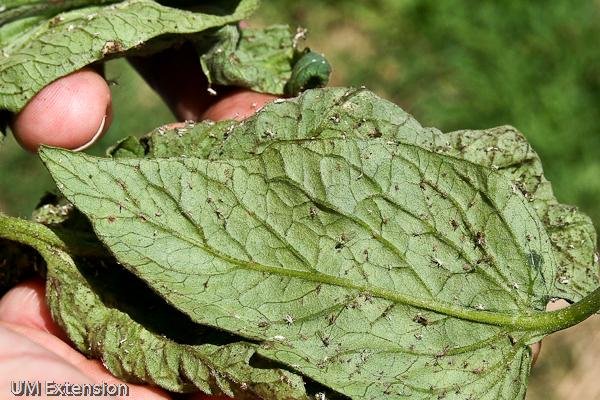Aphids are a common pest for gardeners, particularly those growing tomatoes. These tiny insects can cause significant damage if not managed properly. This guide will explore how to identify aphids on tomato plants, natural remedies for aphid control, and chemical solutions for severe infestations. By understanding and implementing these strategies, you can protect your tomato plants and ensure a bountiful harvest.
Identifying Aphids on Tomato Plants
Appearance and Characteristics
Aphids are small, soft-bodied insects that typically range in color from green to yellow, brown, red, or black, depending on the species. They have pear-shaped bodies and long antennae. Adult aphids are about 1/8 inch long and may have wings, especially when populations are high and they need to migrate to new plants.
Damage to Tomato Plants
Aphids feed by piercing plant tissues and sucking out the sap. This feeding process not only weakens the plant but also transmits viruses and diseases. The symptoms of aphid infestation on tomato plants include:
- Curling Leaves: Aphids often cause the leaves to curl and distort.
- Yellowing and Wilting: The leaves may turn yellow and wilt due to nutrient loss.
- Sticky Residue (Honeydew): Aphids excrete a sugary substance called honeydew, which can lead to the growth of sooty mold on leaves and stems.
- Stunted Growth: Plants may exhibit stunted growth and reduced fruit production.
- Presence of Ants: Ants are attracted to honeydew and may be seen farming aphids for this substance.
Regularly inspecting your tomato plants, especially the undersides of leaves and new growth, can help you detect aphids early and take action before they cause significant damage.
Natural Remedies for Aphid Control
Using natural methods to control aphids can be effective and environmentally friendly. Here are some natural remedies to consider:
Beneficial Insects
- Ladybugs: Ladybugs are natural predators of aphids. You can purchase ladybugs and release them into your garden. They will seek out and consume aphids, reducing the population.
- Lacewings: Lacewing larvae are also effective aphid predators. They can be introduced to your garden to help control aphid infestations.
- Parasitic Wasps: These tiny wasps lay their eggs inside aphids. The hatching larvae consume the aphid from the inside, effectively controlling their numbers.
Homemade Sprays
- Soap and Water Solution: A simple mixture of water and a few drops of mild dish soap can be sprayed directly onto aphids. The soap suffocates the aphids by breaking down their protective outer layer. Be sure to cover all affected areas and repeat the application every few days until the aphids are gone.
- Neem Oil: Neem oil is a natural insecticide that disrupts the feeding and reproduction of aphids. Mix neem oil with water according to the product instructions and spray it on the affected plants.
- Garlic and Pepper Spray: A mixture of crushed garlic and hot pepper can deter aphids. Combine these ingredients with water, let it steep, strain the mixture, and spray it onto the plants.
Companion Planting
Certain plants can repel aphids when planted near your tomatoes. These include:
- Marigolds: Marigolds emit a scent that repels aphids and other pests.
- Nasturtiums: These can act as a trap crop, attracting aphids away from your tomatoes.
- Chives and Garlic: Both emit strong odors that aphids find unappealing.
Chemical Solutions for Severe Infestations

While natural remedies are preferred, sometimes aphid infestations are too severe and require chemical intervention. Here’s how to use chemical treatments safely and effectively:
Insecticidal Soaps
Insecticidal soaps are formulated to control soft-bodied insects like aphids. They are less toxic than other chemical treatments and can be applied directly to the affected plants. Follow the instructions on the product label and ensure thorough coverage.
Horticultural Oils
Horticultural oils, such as dormant oil or summer oil, smother aphids and prevent them from feeding. These oils can be applied during the growing season, but it’s essential to follow the manufacturer’s guidelines to avoid harming the plants.
Systemic Insecticides
The plant absorbs systemic insecticides and can control aphids for an extended period. These insecticides are effective but should be used as a last resort due to their potential impact on beneficial insects and the environment. Apply systemic insecticides according to the product instructions and only when other methods have failed.
Precautions and Safety
When using chemical treatments, always follow these safety precautions:
- Read and Follow Labels: Carefully read and follow all label instructions, including dosage and application methods.
- Protect Yourself: Wear protective clothing, such as gloves and long sleeves, to avoid chemical contact.
- Avoid Beneficial Insects: Apply treatments in the early morning or late evening when beneficial insects are less active.
- Monitor and Reapply: Regularly monitor your plants after treatment and reapply as necessary according to the product guidelines.
Conclusion
Managing aphids on tomato plants requires a combination of vigilance and effective strategies. By identifying aphids early, utilizing natural remedies, and resorting to chemical solutions only when necessary, you can protect your tomato plants and enjoy a healthy, productive garden. Always consider the impact on the environment and beneficial insects when choosing your control methods.
For more information on related gardening topics, you can check out our article on how to make a slave in Infinity Craft: A Step-by-Step Guide.

Jason Bennett is a tech enthusiast and software engineer with a passion for the latest gadgets and technological advancements. With a decade of experience in the tech industry, Jason offers in-depth reviews, analyses, and tips on the newest devices and software. His expert knowledge and keen eye for detail make him a trusted voice in the world of technology.




